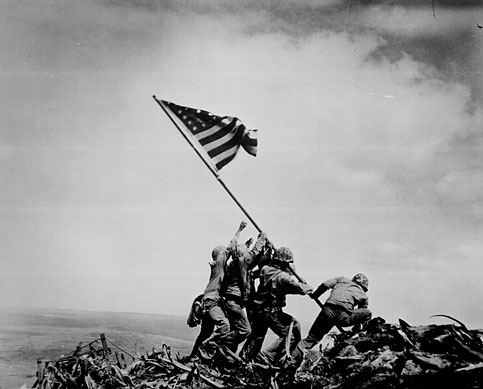Flags Of Our Fathers is the widely acclaimed film by Clint Eastwood. The now famous picture of the American flag being raised in Iwo Jima was a simple act – an order being carried out by six men. In fact, it was a replacement flag since the first flag that was raised had to be lowered to be provided as a trophy to some muckety-muck. But the picture taken by AP photographer Joe Rosenthal has become part of American lore.
 Flags Of Our Fathers takes a realistic look at the events that led to the raising of the flag and lives of the men who were enshrined as heroes for cynical, marketing purposes.
Flags Of Our Fathers takes a realistic look at the events that led to the raising of the flag and lives of the men who were enshrined as heroes for cynical, marketing purposes.
In the film, the raising of the flag itself was a humdrum affair, like it probably was in reality. The men find a pole, tie on the flag and a motley crew who are present help raise it. The fact the film gives it passing importance reflects how the men involved thought about it. But when the photograph is seen in America, the press and the politicians see an opportunity to reignite Americans behind the war effort.
The flag was raised on day five of a forty-day war, clearly not the a sign of victory that it came to represent. By the end of that battle, three of the six men who raised the flag are dead. The other three, John “Doc” Bradley (Ryan Phillippe), Rene Gagnon (Jesse Bradford) and Ira Hayes (Adam Beach) are termed heroes and shipped back to the US to help raise money for the war by encouraging the public to buy war bonds. Phillippe, played the role very understated, but also very powerfully. Adam Beach was excellent as the Native American who, despite his bravery in the war, despite being a “hero”, is faced with overt racism.
Eastwood did the following things really well.
- The movie cuts from present day, when Doc Bradley has just died, to their money raising efforts to the battle itself. While nested flashbacks have been done before, here it works really well.
- For the scenes at Iwo Jima, he didn’t shoot in black and white (which is what we’ve come to expect from World War II films). Instead he shot in color and then drained the color from it, leaving skin tones in. Very powerful way to demarcate those scenes.
- The music was excellent. The music didn’t hit the audience over the head, it was subtle, almost a lullaby. And it made the film much better. A lot of the music was composed by Eastwood himself.
- He let the acting be subtle.
- He used a light touch. One of the underlying threads of the film is a scene where Doc Bradley leaves his friend Iggy in a foxhole to go tend to an injured soldier. When he returns, Iggy is gone and he searches frantically for him with no luck. Late in the movie, Iggy is finally found. Eastwood shows us only Phillippe’s reaction to what he found. The profound shock, the sadness at how Iggy was treated. He does not show us Iggy’s mutilated body. He didn’t need to. By not showing every gory detail of the war, but instead protecting the audience, Eastwood makes the film more powerful.
Overall, a very good film. An honest film that does not dress up the reality, either of the war or how poorly the “heroes” were treated after their usefulness was fulfilled. It calls out how it is the media and politicians who need to create heroes out of ordinary people doing their jobs. Ordinary people who don’t want the burden or the benefits that the title bestows.
And it is timely. Makes you wonder which of the rah-rah pictures we see today are marketing gimmicks.

2 thoughts on “Flags Of Our Fathers”